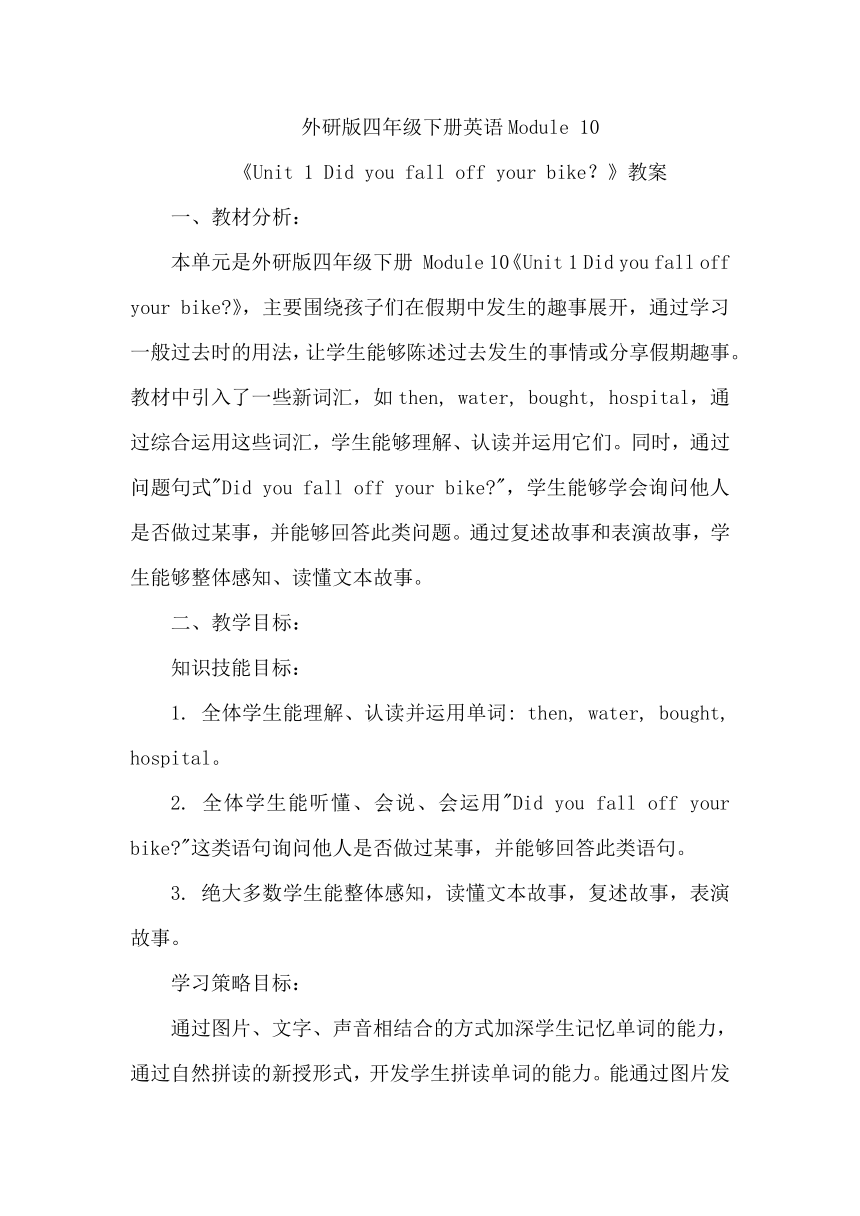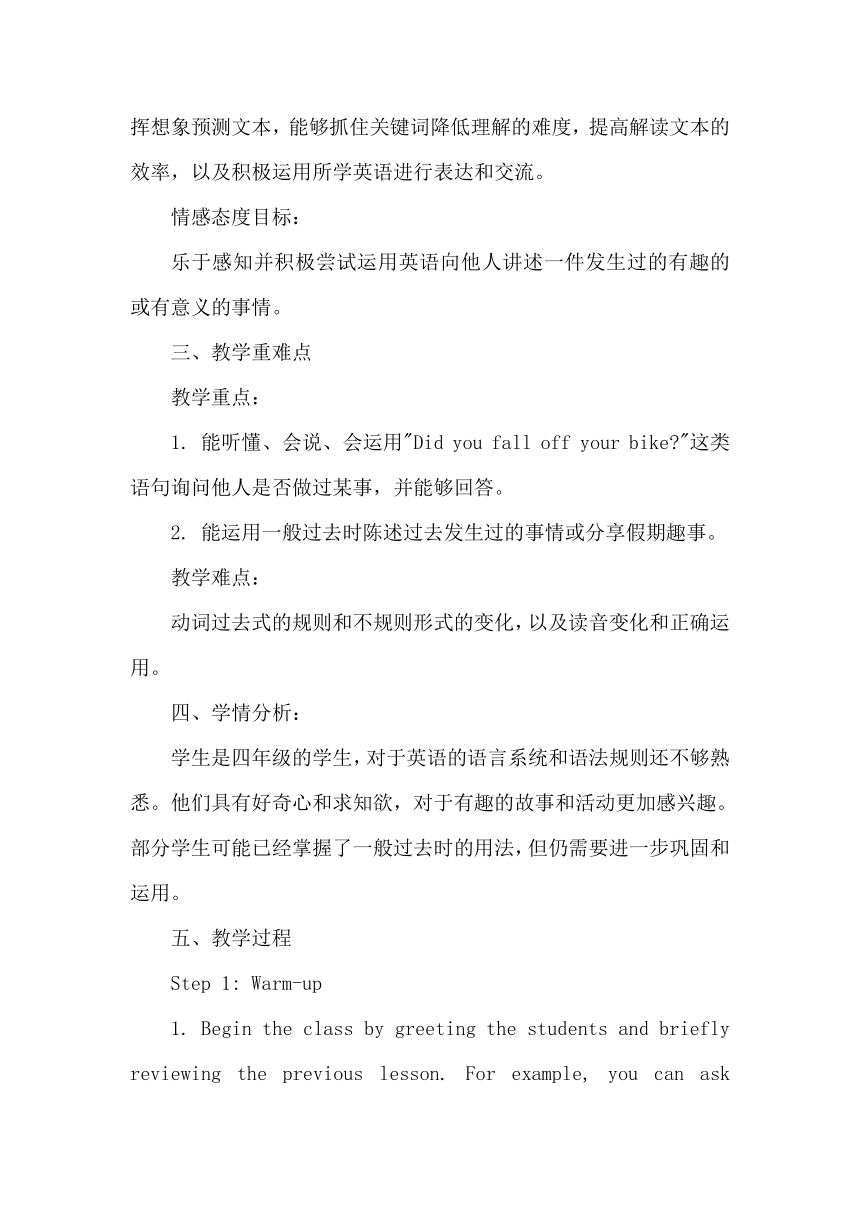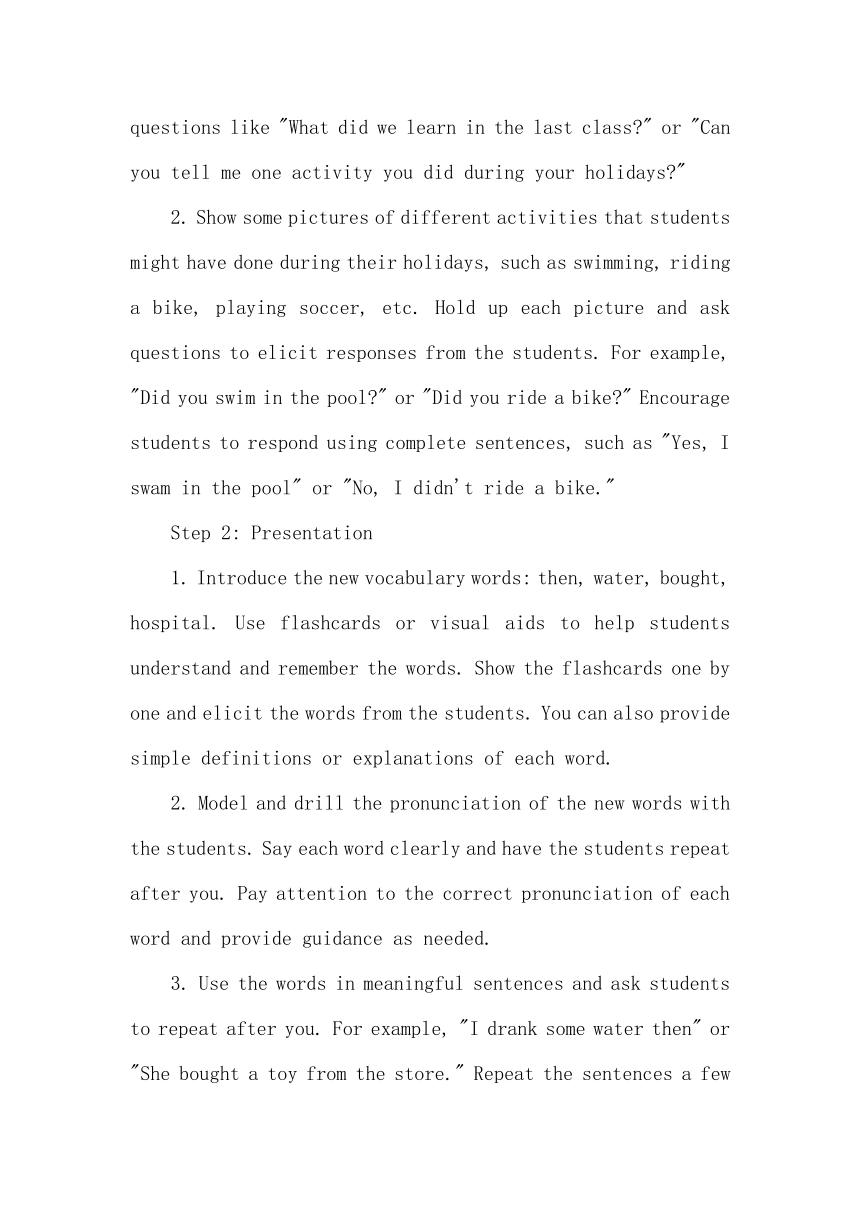Module 10 Unit 1 Did you fall off your bike? 教案含反思
文档属性
| 名称 | Module 10 Unit 1 Did you fall off your bike? 教案含反思 |  | |
| 格式 | docx | ||
| 文件大小 | 14.5KB | ||
| 资源类型 | 教案 | ||
| 版本资源 | 外研版(三年级起点) | ||
| 科目 | 英语 | ||
| 更新时间 | 2024-03-17 13:59:14 | ||
图片预览



文档简介
外研版四年级下册英语Module 10
《Unit 1 Did you fall off your bike?》教案
一、教材分析:
本单元是外研版四年级下册 Module 10《Unit 1 Did you fall off your bike 》,主要围绕孩子们在假期中发生的趣事展开,通过学习一般过去时的用法,让学生能够陈述过去发生的事情或分享假期趣事。教材中引入了一些新词汇,如then, water, bought, hospital,通过综合运用这些词汇,学生能够理解、认读并运用它们。同时,通过问题句式"Did you fall off your bike ",学生能够学会询问他人是否做过某事,并能够回答此类问题。通过复述故事和表演故事,学生能够整体感知、读懂文本故事。
二、教学目标:
知识技能目标:
1. 全体学生能理解、认读并运用单词: then, water, bought, hospital。
2. 全体学生能听懂、会说、会运用"Did you fall off your bike "这类语句询问他人是否做过某事,并能够回答此类语句。
3. 绝大多数学生能整体感知,读懂文本故事,复述故事,表演故事。
学习策略目标:
通过图片、文字、声音相结合的方式加深学生记忆单词的能力,通过自然拼读的新授形式,开发学生拼读单词的能力。能通过图片发挥想象预测文本,能够抓住关键词降低理解的难度,提高解读文本的效率,以及积极运用所学英语进行表达和交流。
情感态度目标:
乐于感知并积极尝试运用英语向他人讲述一件发生过的有趣的或有意义的事情。
三、教学重难点
教学重点:
1. 能听懂、会说、会运用"Did you fall off your bike "这类语句询问他人是否做过某事,并能够回答。
2. 能运用一般过去时陈述过去发生过的事情或分享假期趣事。
教学难点:
动词过去式的规则和不规则形式的变化,以及读音变化和正确运用。
四、学情分析:
学生是四年级的学生,对于英语的语言系统和语法规则还不够熟悉。他们具有好奇心和求知欲,对于有趣的故事和活动更加感兴趣。部分学生可能已经掌握了一般过去时的用法,但仍需要进一步巩固和运用。
五、教学过程
Step 1: Warm-up
1. Begin the class by greeting the students and briefly reviewing the previous lesson. For example, you can ask questions like "What did we learn in the last class " or "Can you tell me one activity you did during your holidays "
2. Show some pictures of different activities that students might have done during their holidays, such as swimming, riding a bike, playing soccer, etc. Hold up each picture and ask questions to elicit responses from the students. For example, "Did you swim in the pool " or "Did you ride a bike " Encourage students to respond using complete sentences, such as "Yes, I swam in the pool" or "No, I didn't ride a bike."
Step 2: Presentation
1. Introduce the new vocabulary words: then, water, bought, hospital. Use flashcards or visual aids to help students understand and remember the words. Show the flashcards one by one and elicit the words from the students. You can also provide simple definitions or explanations of each word.
2. Model and drill the pronunciation of the new words with the students. Say each word clearly and have the students repeat after you. Pay attention to the correct pronunciation of each word and provide guidance as needed.
3. Use the words in meaningful sentences and ask students to repeat after you. For example, "I drank some water then" or "She bought a toy from the store." Repeat the sentences a few times, emphasizing the correct pronunciation and intonation.
Step 3: Listening and Speaking
1. Play an audio recording or read aloud the story "Did you fall off your bike " from the textbook. Encourage students to listen carefully and follow along in their books.
2. After reading, ask comprehension questions to check understanding. For example, "Did Sarah fall off her bike " or "Where did they go after the accident " Allow students to answer the questions and provide positive reinforcement for their responses.
3. Have students work in pairs and take turns asking each other questions using the sentence pattern "Did you...fall off your bike " Encourage students to answer using complete sentences. Provide support and guidance as needed. For example, one student can ask, "Did you fall off your bike yesterday " and the other student can respond, "No, I didn't fall off my bike. I rode it safely."
Step 4: Reading and Retelling
1. Have students read the story individually or in pairs. Ask them to pay attention to the main events and key details.
2. Ask students to retell the story using their own words, emphasizing the main events and key details. Encourage them to include the vocabulary words and sentence pattern practiced earlier. Provide prompts and guiding questions if necessary. For example, "What happened at the beginning of the story " or "How did the characters feel after the accident "
3. Select a few students to share their retellings with the class. Provide positive feedback and encourage other students to ask questions or add additional details to the retellings.
Step 5: Role Play
1. Divide the class into small groups and assign roles from the story. Each group can act out a specific scene or dialogue from the story.
2. Encourage students to act out the story using the dialogue and expressions from the book. They can take turns playing different roles and practice using the sentence pattern "Did you...fall off your bike " in their dialogues.
3. Monitor the groups and provide feedback and support as needed. Encourage creativity and allow students to add their own ideas or variations to the role plays.
Step 6: Grammar Practice
1. Introduce the concept of regular past tense verbs and irregular past tense verbs. Write examples of regular verbs (e.g., play-played, watch-watched) and irregular verbs (e.g., go-went, eat-ate) on the board.
2. Explain the pattern and exceptions of regular and irregular past tense verbs. Provide clear explanations and examples for each type of verb. You can also use gestures or actions to reinforce the meaning of the verbs.
3. Give students practice exercises with regular and irregular past tense verbs. This can be done through worksheets or interactive activities. For example, provide sentences with missing verbs and ask students to fill in the correct past tense form.
Step 7: Wrap-up and Extension
1. Review the key vocabulary words, sentence pattern, and grammar points covered in the lesson. Ask students to provide definitions or examples using the vocabulary words and sentence pattern.
2. Assign homework tasks, such as writing a short paragraph about a past event using past tense verbs or creating a dialogue using regular and irregular past tense verbs.
3. Encourage students to share their stories or dialogues in the next class. Provide positive feedback and praise for their efforts in using past tense correctly.
六、板书设计:
[Key Vocabulary]
Then,water,bought,hospital
[Question Sentence Pattern]
Did you fall off your bike
[Grammar]
1.Regular past tense verbs: play-played, watch-watched
2.Irregular past tense verbs: go-went, eat-ate
七、教学反思:
本节课通过图片、文字、声音相结合的方式,帮助学生学习并记忆了新单词,并通过问题句式以及故事的方式让学生能够运用所学语句进行交流。教学过程中,教师积极引导学生参与,通过小组活动和角色扮演等互动形式,提高学生的听说能力。在语法教学环节,教师采用了分类讲解的方式,帮助学生理解动词过去式的规则和不规则形式的变化。通过本节课的教学,学生能够理解、运用相关词汇和句型,并能够通过复述、表演等形式展示所学知识。
《Unit 1 Did you fall off your bike?》教案
一、教材分析:
本单元是外研版四年级下册 Module 10《Unit 1 Did you fall off your bike 》,主要围绕孩子们在假期中发生的趣事展开,通过学习一般过去时的用法,让学生能够陈述过去发生的事情或分享假期趣事。教材中引入了一些新词汇,如then, water, bought, hospital,通过综合运用这些词汇,学生能够理解、认读并运用它们。同时,通过问题句式"Did you fall off your bike ",学生能够学会询问他人是否做过某事,并能够回答此类问题。通过复述故事和表演故事,学生能够整体感知、读懂文本故事。
二、教学目标:
知识技能目标:
1. 全体学生能理解、认读并运用单词: then, water, bought, hospital。
2. 全体学生能听懂、会说、会运用"Did you fall off your bike "这类语句询问他人是否做过某事,并能够回答此类语句。
3. 绝大多数学生能整体感知,读懂文本故事,复述故事,表演故事。
学习策略目标:
通过图片、文字、声音相结合的方式加深学生记忆单词的能力,通过自然拼读的新授形式,开发学生拼读单词的能力。能通过图片发挥想象预测文本,能够抓住关键词降低理解的难度,提高解读文本的效率,以及积极运用所学英语进行表达和交流。
情感态度目标:
乐于感知并积极尝试运用英语向他人讲述一件发生过的有趣的或有意义的事情。
三、教学重难点
教学重点:
1. 能听懂、会说、会运用"Did you fall off your bike "这类语句询问他人是否做过某事,并能够回答。
2. 能运用一般过去时陈述过去发生过的事情或分享假期趣事。
教学难点:
动词过去式的规则和不规则形式的变化,以及读音变化和正确运用。
四、学情分析:
学生是四年级的学生,对于英语的语言系统和语法规则还不够熟悉。他们具有好奇心和求知欲,对于有趣的故事和活动更加感兴趣。部分学生可能已经掌握了一般过去时的用法,但仍需要进一步巩固和运用。
五、教学过程
Step 1: Warm-up
1. Begin the class by greeting the students and briefly reviewing the previous lesson. For example, you can ask questions like "What did we learn in the last class " or "Can you tell me one activity you did during your holidays "
2. Show some pictures of different activities that students might have done during their holidays, such as swimming, riding a bike, playing soccer, etc. Hold up each picture and ask questions to elicit responses from the students. For example, "Did you swim in the pool " or "Did you ride a bike " Encourage students to respond using complete sentences, such as "Yes, I swam in the pool" or "No, I didn't ride a bike."
Step 2: Presentation
1. Introduce the new vocabulary words: then, water, bought, hospital. Use flashcards or visual aids to help students understand and remember the words. Show the flashcards one by one and elicit the words from the students. You can also provide simple definitions or explanations of each word.
2. Model and drill the pronunciation of the new words with the students. Say each word clearly and have the students repeat after you. Pay attention to the correct pronunciation of each word and provide guidance as needed.
3. Use the words in meaningful sentences and ask students to repeat after you. For example, "I drank some water then" or "She bought a toy from the store." Repeat the sentences a few times, emphasizing the correct pronunciation and intonation.
Step 3: Listening and Speaking
1. Play an audio recording or read aloud the story "Did you fall off your bike " from the textbook. Encourage students to listen carefully and follow along in their books.
2. After reading, ask comprehension questions to check understanding. For example, "Did Sarah fall off her bike " or "Where did they go after the accident " Allow students to answer the questions and provide positive reinforcement for their responses.
3. Have students work in pairs and take turns asking each other questions using the sentence pattern "Did you...fall off your bike " Encourage students to answer using complete sentences. Provide support and guidance as needed. For example, one student can ask, "Did you fall off your bike yesterday " and the other student can respond, "No, I didn't fall off my bike. I rode it safely."
Step 4: Reading and Retelling
1. Have students read the story individually or in pairs. Ask them to pay attention to the main events and key details.
2. Ask students to retell the story using their own words, emphasizing the main events and key details. Encourage them to include the vocabulary words and sentence pattern practiced earlier. Provide prompts and guiding questions if necessary. For example, "What happened at the beginning of the story " or "How did the characters feel after the accident "
3. Select a few students to share their retellings with the class. Provide positive feedback and encourage other students to ask questions or add additional details to the retellings.
Step 5: Role Play
1. Divide the class into small groups and assign roles from the story. Each group can act out a specific scene or dialogue from the story.
2. Encourage students to act out the story using the dialogue and expressions from the book. They can take turns playing different roles and practice using the sentence pattern "Did you...fall off your bike " in their dialogues.
3. Monitor the groups and provide feedback and support as needed. Encourage creativity and allow students to add their own ideas or variations to the role plays.
Step 6: Grammar Practice
1. Introduce the concept of regular past tense verbs and irregular past tense verbs. Write examples of regular verbs (e.g., play-played, watch-watched) and irregular verbs (e.g., go-went, eat-ate) on the board.
2. Explain the pattern and exceptions of regular and irregular past tense verbs. Provide clear explanations and examples for each type of verb. You can also use gestures or actions to reinforce the meaning of the verbs.
3. Give students practice exercises with regular and irregular past tense verbs. This can be done through worksheets or interactive activities. For example, provide sentences with missing verbs and ask students to fill in the correct past tense form.
Step 7: Wrap-up and Extension
1. Review the key vocabulary words, sentence pattern, and grammar points covered in the lesson. Ask students to provide definitions or examples using the vocabulary words and sentence pattern.
2. Assign homework tasks, such as writing a short paragraph about a past event using past tense verbs or creating a dialogue using regular and irregular past tense verbs.
3. Encourage students to share their stories or dialogues in the next class. Provide positive feedback and praise for their efforts in using past tense correctly.
六、板书设计:
[Key Vocabulary]
Then,water,bought,hospital
[Question Sentence Pattern]
Did you fall off your bike
[Grammar]
1.Regular past tense verbs: play-played, watch-watched
2.Irregular past tense verbs: go-went, eat-ate
七、教学反思:
本节课通过图片、文字、声音相结合的方式,帮助学生学习并记忆了新单词,并通过问题句式以及故事的方式让学生能够运用所学语句进行交流。教学过程中,教师积极引导学生参与,通过小组活动和角色扮演等互动形式,提高学生的听说能力。在语法教学环节,教师采用了分类讲解的方式,帮助学生理解动词过去式的规则和不规则形式的变化。通过本节课的教学,学生能够理解、运用相关词汇和句型,并能够通过复述、表演等形式展示所学知识。
同课章节目录
- Module 1
- Unit 1 She's a nice teache
- Unit 2 He's cool.
- Module 2
- Unit 1 London is a big city.
- Unit 2 It's very old.
- Module 3
- Unit 1 Robots will do everything.
- Unit 2 On Monday I'll go swimming.
- Module 4
- Unit 1 Will you take your kite?
- Unit 2 Will it be hot in Haikou?
- Module 5
- Unit 1 I was two then.
- Unit 2 They were young.
- Module 6
- Unit 1 Were you at home yesterday?
- Unit 2 Was it a big city then ?
- Module 7
- Unit 1 I helped Mum.
- Unit 2 Grandma cooked fish.
- Module 8
- Unit 1 They sang beautifully.
- Unit 2 I took some pictures.
- Module 9
- Unit 1 Did he live in New York ?
- Unit 2 Did you have a nice holiday?
- Review Module
- Unit 1
- Unit 2
- Module 10
- Unit 1 Did you fall off your bike?
- Unit 2 Sam had lots of chocolate.
